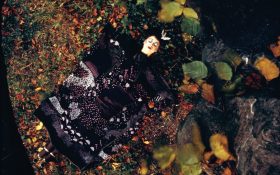Norwich Castle is a four-square, Caen stone clad monster of a Keep which dominates the centre of the city at least as much as the Cathedral does. It was William I’s only East Anglian castle and his soldiers had to displace 98 homes to make way for it. We live in more peaceful times, at least on the home front, and this is now the home of the city’s Museum and Art Gallery.
The gallery is appropriately home to large collections of the Norwich School painters, notably Crome and Cotman, who each have their own galleries. With Cotman, there are two generations (his two sons are here too) so it gets a bit confusing. Crome also had a well-known artist son, but I couldn’t find any of his works. Scholars of English early 19th century landscape painting, oil and watercolour, will find much to satisfy their curiosity although so many similar views, side by side, depicting the rural idyll can leave others desperate for relief. The gallery identifies Cotman’s Silver Birches as possibly the finest in their Norwich School collection, and I think they may be right.
There’s much more to see. They have here Tobias Verhaecht’s famous and massive (roughly 2 metres square) Tower of Babel, from the late 16th or early 17th century. It might perhaps have been hung to better effect but nevertheless its impact is as enormous as its physical size. Chagall’s L’Artiste dans son Atelier is a colourful pastel, pencil and crayon drawing from 1930 and is located in a wing which provides a complete contrast to the Norwich School areas. Here, there is one representative piece from many of the names of the last hundred years, all hanging in apparently random order. Thus we see Briget Riley’s The Edge of Day (1981), for which she uses her Egyptian palette, next to Robert Denny’s Night Suite C (1970), a geometric screen print in yellows and creams. Across the room, Sam Taylor Wood’s 5 Revolutionary Seconds (1995), a pun title for this photographic work which seems to lack artistry, sits close by Warhol’s Pom, a two colour screen print not of the highest order. Magritte is here too. It’s an interesting room and the Riley is the stand out for me. It would go very well on our end wall.
The current exhibition, Museum of Life, runs until 16th September, and is one which the Gallery commissioned from the installation artist Karsten Bott. He was invited to create a museum within the museum, using his ‘Archive of Contemporary History’, now 19 years in the making, for his source material. Two adjoining gallery spaces are filled with items from his collection, the design, value or rarity of each piece being of little or no interest to Bott himself. Typically they are previously enjoyed everyday objects gathered from car boot sales, charity shops or skips and he arranges them either randomly or in themed categories – both methods are employed here. In one of the spaces 380 shelved compartments face each other across the room, simply displaying thousands of pieces of ephemera. There is something there for everyone. A common response is “Oooh, look, I used to have one of those.” And indeed, I did. There’s an aluminium four-compartment egg poacher that my mother had, an Alessi lemon squeezer, pages torn from diaries, an empty bottle of wine, random shoes, a snorkel, footballing figures, a fax machine, a walking stick. Get the picture?
He keeps his Archive of half a million pieces in thousands of banana boxes in a warehouse that’s also his studio. If there’s a Frau Bott, I should imagine that she long since laid down the ground rules: Don’t bring your work home!
I found myself liking this installation. My responses were normal and, although there were few others there when I visited, those that were stayed longer than they probably would have done in a room full of conventionial art. They, like I, also engaged the attention of the gallery staff, gaining more insight into the complexity of both the art and its creator.
I recognised a kindred spirit, which is just a little bit scary. I’d still rather have the Riley.




